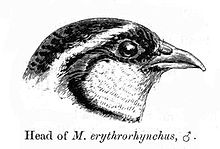Painted bush quail
| Painted bush quail | |
|---|---|

| |
| A maleP. e. erythrorhynchawith chick. | |
| Scientific classification | |
| Domain: | Eukaryota |
| Kingdom: | Animalia |
| Phylum: | Chordata |
| Class: | Aves |
| Order: | Galliformes |
| Family: | Phasianidae |
| Genus: | Perdicula |
| Species: | P. erythrorhyncha
|
| Binomial name | |
| Perdicula erythrorhyncha | |
| Synonyms | |
|
Microperdix erythrorhynchus | |
Thepainted bush quail(Perdicula erythrorhyncha) is a species ofquailfound in the hill forests ofIndia.They move in small coveys on hillsides and are distinguished by their red bills and legs. They have a liquid alarm call and small groups will run in single file along paths before taking flight when flushed.
Description
[edit]
This quail is darkish brightly colored with a deep red bill and legs, eye-catching even in flight. The female has brick-red underpart and lacks the white throat and head stripe of the male. The male has a black face with a white supercilium and throat. These quail are typically found in a covey of 6 to 10 birds. They come out in open grassy patches or on forest roads and cart tracks to feed on seeds or grain (and small insects[3]) and dust-bathe in the morning and evening. The covey quickly reunites by the constant call of the members to one another. A series of soft whistles are heard when members of a scattered covey regroup. The territorial call of male is a pleasant, oft-repeated triple notekirikee-kirikee-kirikee.[4][5][6]
It is 6.6–7.5 in (17–19 cm)longand weighs roughly 2.4–3.1 oz (68–88 g).[7]
Distribution and habitat
[edit]This species is mainly found in the hill forests of peninsular India. There are two apparently disjunct populations. Subspeciesblewittiis found in theSatpurasand extends into the northernEastern Ghats(East to Lammasinghi[8]). This subspecies was described byHumeand named after F.R. Blewitt who sent him specimens from Raipur. The male has the frontal black band narrower and the white band around it being broader. The chestnut on the belly is paler.[9]Overall,blewittiis smaller and paler than the nominate subspecies of theWestern Ghats(south ofPune.Sykes described the nominate form based on specimens from the valley of "Karleh",[2]35 miles northwest of Pune[10]), theNilgirisand hills of southern India including theBiligirirangansandShevaroys.[5]
Behaviour and ecology
[edit]
These quails are usually seen in small groups of 8 to 10. When flushed they scatter in different directions and then begin rally calling to reunite. Males are believed to be monogynous.[11]They are pugnacious and trappers are known to use decoy males to capture others.[12]The call of the breeding male is akirkee..kirkeeand other calls include soft whistles which rises and falls in pitch.[11] Thenesting seasonvaries locally, but is said to breed mainly in December to March.Nestsare typically found in the ground at the root of a bush or grass clump, sometimes thinly lined with grass. The female lays 4 to 7 eggs at a time, which are incubated by the female alone for 16–18 days before hatching. Females are said to defend their young often by attacking dogs and even humans that intrude.[13]Chicks are said to be able to fly at a very early age.[11]
A flagellate parasiteHypotrichomonas avium(Parabasalia:Hypotrichomonadida) was described from a specimen found in the intestine of a painted bush quail.[14]
References
[edit]- ^BirdLife International (2016)."Perdicula erythrorhyncha".IUCN Red List of Threatened Species.2016:e.T22679007A92798106.doi:10.2305/IUCN.UK.2016-3.RLTS.T22679007A92798106.en.Retrieved12 November2021.
- ^abSykes, W.H. (1832)."Catalogue of Birds (systematically arranged) of the Rasorial, Grallatorial, and Natatorial Orders, observed in the Dukhun".Proceedings of the Zoological Society of London.Part 2: 149–172.
- ^Mason, C.W. (1912)."The food of birds in India".Memoirs of the Department of Agriculture in India. Entomological Series.3:234.
- ^Primrose, AP (1916)."Notes on the Painted Bush QuailMicroperdix erythrorhynchusF.B.I. 1359 ".J. Bombay Nat. Hist. Soc.24(3): 597.
- ^abJerdon, TC (1864).The Birds of India. Volume 3.George Wyman & Co. pp. 584–585.
- ^Rasmussen PC & JC Anderton (2005).Birds of South Asia: The Ripley Guide. Volume 2.Smithsonian Institution & Lynx Edicions. pp. 125–126.
- ^Hume, A.O.; Marshall, C.H.T. (1880).Game Birds of India, Burmah and Ceylon.Vol. II. Calcutta: A.O. Hume and C.H.T. Marshall. p. 127.
- ^Price, Trevor D. (1980)."The seasonality and occurrence of birds in the Eastern Ghats of Andhra Pradesh".Journal of the Bombay Natural History Society.76(3): 379–422.
- ^Hume, A.O. (1874)."Novelties. Microperdix blewitti, Sp. Nov".Stray Feathers.2(6): 512–513.
- ^Sykes, W.H. (1857)."On the Geology of a portion of Dukhun, East Indies".In Carter, Henry J. (ed.).Geological papers on Western India, including Cutch, Sinde, and the South-East coast of Arabia.Bombay: Government of India. pp. 89–115.
- ^abcAli, S & SD Ripley (1980).Handbook of the Birds of India and Pakistan. Volume 2(2nd ed.). Oxford University Press. pp. 51–53.
- ^Baker, EC Stuart (1924)."The game birds of India, Burma and Ceylon. Part 37".J. Bombay Nat. Hist. Soc.29(4): 850–863.
- ^Daly, WM (1887)."The Bush QuailPerdicula erythroryncha".J. Bombay Nat. Hist. Soc.2(2): 149.
- ^Navarathnam, E.S. (1970). "Hypotrichomonas avium n. sp. from the bird Cryptoplectron erythrorhynchum".Riv. Parassitol.31(4): 251–254.PMID5535603.

